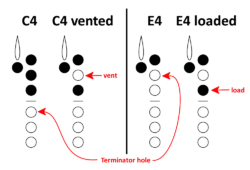Music
These are the scores and recordings of pieces written for this project. [starting to add draft scores to this, much more to come]
See bottom of page for terminology.
Studies
These are aimed at developing basic techniques and tools that will be assumed for other pieces.
- Loading study no.1 (v.2) <score> <audio>
- 'loading' means closing additional holes downstream of the terminator hole* of the fingering. Loading has the effect of flattening the pitch to varying degrees, and in clarino register can also shift between harmonics.
- Audio performed by Heather Roche
- 'loading' means closing additional holes downstream of the terminator hole* of the fingering. Loading has the effect of flattening the pitch to varying degrees, and in clarino register can also shift between harmonics.
- Chalumeau venting study no.1 (v.1) <score> <audio>
- 'venting' means opening holes upstream of the terminator hole, which—in the chalumeau and clarino registers—can also be seen as reverse-loading since it raises pitch: essentially venting creates a new terminator hole that comes pre-loaded since some downstream holes are already closed by the original fingering.
- <video> Heather Roche advice for learning 'chalumeau venting study #1'
- Audio performed by Heather Roche
- Register venting study no.1 (v.1) <score> <recording>
- 'venting' can also be used to change register. By using half-holes, different holes can be used as register holes to suppress the chalumeau pitch and reveal upper harmonics (usually 5th and 7th partials here). Different half-holes can reveal different partials, often mistuned. The size of half-hole also affects which partial wants to speak, with some half-holes affording several possible partials.
- Register Venting with Embouchure Shifts (v.1) <score> <score alt. notation> <audio>
- This piece begins with chalumeau venting, but uses repeats and loops to go over the same territory in different ways. On the 2nd repeat, use gentle raising/tightening of the embouchure and breath to gently bring out overblown multiphonic and harmonic tones. On the 3rd repeat, use altissimo techniques to bring out very high harmonics that may change as you loop phrases.
- Register venting contingent tones "wax & wane" (v.1) <score> <audio>
- This is a loose text score for an exercise in slowly uncovering vent holes and supporting whatever pitches want to emerge. This exercise trains control, responsiveness, and listening.
Solos
- Daisychains project
- Maquette for Natura Naturans. <score> <audio>
- Written for Heather Roche as a study for the concerto Natura Naturans.
- Natura Naturans. <score> <audio>
- Concerto for clarinet and string orchestra. Commissioned for Tectonics 2021
- [not a solo piece strictly, but the only ensemble piece here, and relates to the piece above.
- Natura Naturans II.
- Arrangement for chamber ensemble (2 vln, 2 vla, 2vc) of the concerto above. Requested by Apartment House ensemble and Heather Roche.
- Strata <score> <audio>
- Written for Carlos Cordeiro, this piece uses a modified clarinet barrel with additional vent holes (blocked with cork).
- Here is a video player that randomly plays different recordings by Carlos Cordeiro of the main piece and the coda (which is for barrel only).
- Fringing <score> <video>
- Written for Heather Roche for HCMF 2021.
- an instrument is polarised inside itself. <score> <audio>
- Written for Jonathan Sage for the York Late Music Festival 2022 for basset clarinet.
- for Bb clarinet version (and other clarinets without low-C extension), see here for score.
Duets
- Venting Game Duet (v.1) <score> <video>
- A game piece for two players using a combination of chalumeau and overblown venting.
* Terminology

The same fingering read as C4 vented or as E4 loaded, and terminator hole (where the main pitch emerges, i.e. where its vibrating air-column terminates). Terminator changes with register, for chalumeau/clarino it's the highest open hole, or thinking another way, the shortest tube from the reed. In this example, the C4 terminator is the first open hole below the reed, but in the 'C4 vented' the terminator hole moves up to the 'vent' hole, which is now the first open hole below the reed, and consequently the chalumeau pitch is raised. In both E4 examples the terminator stays the same.
